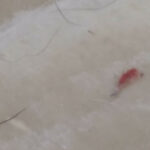Hookworms are parasitic roundworms that can live in human intestines, causing diarrhea, stomach cramps, and in severe cases anemia and protein deficiency. They are so named because of the sharp spikes surrounding the mouth of an adult worm – resembling fangs under an electron microscope – used to attach to host tissues.
Hook worm eggs are passed in the stool of infected individuals, and hatch in soil contaminated with infected feces. Larvae in the soil can then infect another individual through the skin, especially on bare feet. Burrowing through the skin, the larvae enter the bloodstream and travel to the lungs, crawling up to the throat where they can be swallowed, and then passing through the digestive tract. As mature adults, they attach themselves to the blood-rich wall of the small intestine and suck the host’s blood to obtain nutrients. Adults lay thousands of eggs, which will be passed in feces, completing the cycle. Hook worms can maintain this parasitic existence over a lifespan of ten years!
Hook worm cannot be transmitted from person to person, because eggs must hatch externally and enter the skin as larvae. Less commonly, infection can occur when larvae or eggs in contaminated soil or water are swallowed.
Direct contact with soil contaminated with human feces, especially in areas where hook worm is common, risks infection. Therefore wearing shoes in such areas is an important precaution. Children tend to have a higher risk of infection, as they play in (and eat) dirt and commonly go barefoot.
Symptoms of initial infection include skin irritation or itching rash. Sites where larvae enter the skin can resemble mosquito bites. Mild infections may elicit no symptoms. Diarrhea and intestinal cramps are common symptoms, and severe infections can cause anemia and protein deficiency, heart problems, fatigue, breathing difficulty, loss of appetite and weight loss.
Diagnosis is made by observation of eggs in a stool sample. Mebendazole (brand names Vermox and Pripsen) is the most common drug used to treat hook worm, eliminating 99% of infections. Iron supplements and a high protein diet can help alleviate anemia and protein deficiency. Symptoms may take weeks or months to improve, as nutrients lost to the parasite are replenished.
Estimates range up to one billion infected individuals globally—as much as twenty percent of the world’s population. Two species of hookworms can infect humans: Ancylostoma duodenale (adults are about 1/4 inch long) and Necator americanus (about 1/2 inch). Both species flourish in warm, moist climates.
Closely related hook worm species can infect cats and dogs. Although they cannot establish an infection in human intestines, the larvae can burrow into human skin, causing painful itching and exposing the skin to secondary infection by bacteria. These species are endemic among pets, especially puppies and kittens. Therefore, the CDC recommends screening and treating pets for worm infections, and protecting children from playing in dirt that may be contaminated.
All About Worms is always free, always reader-supported. Your tips via CashApp, Venmo, or Paypal are appreciated! Receipts will come from ISIPP Publishing.














